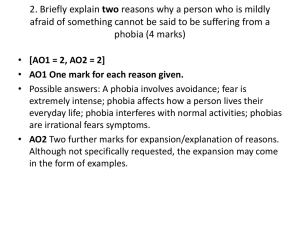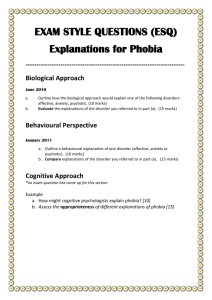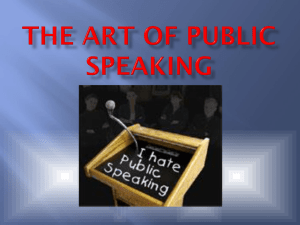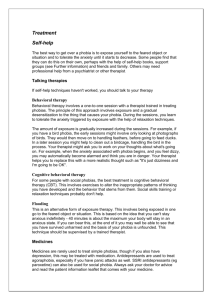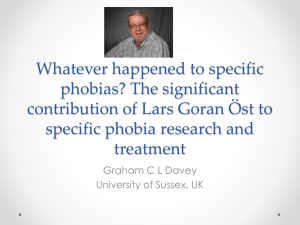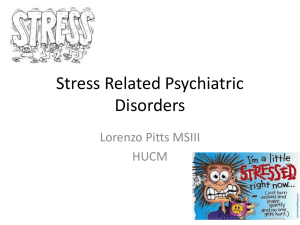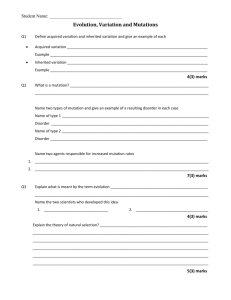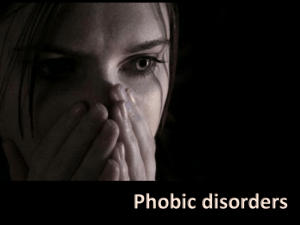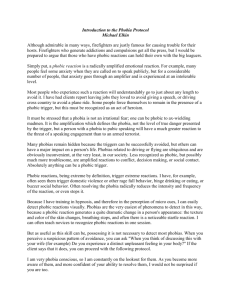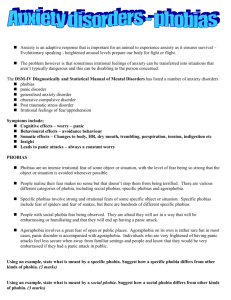Sample question and answer for phobic disorders
advertisement
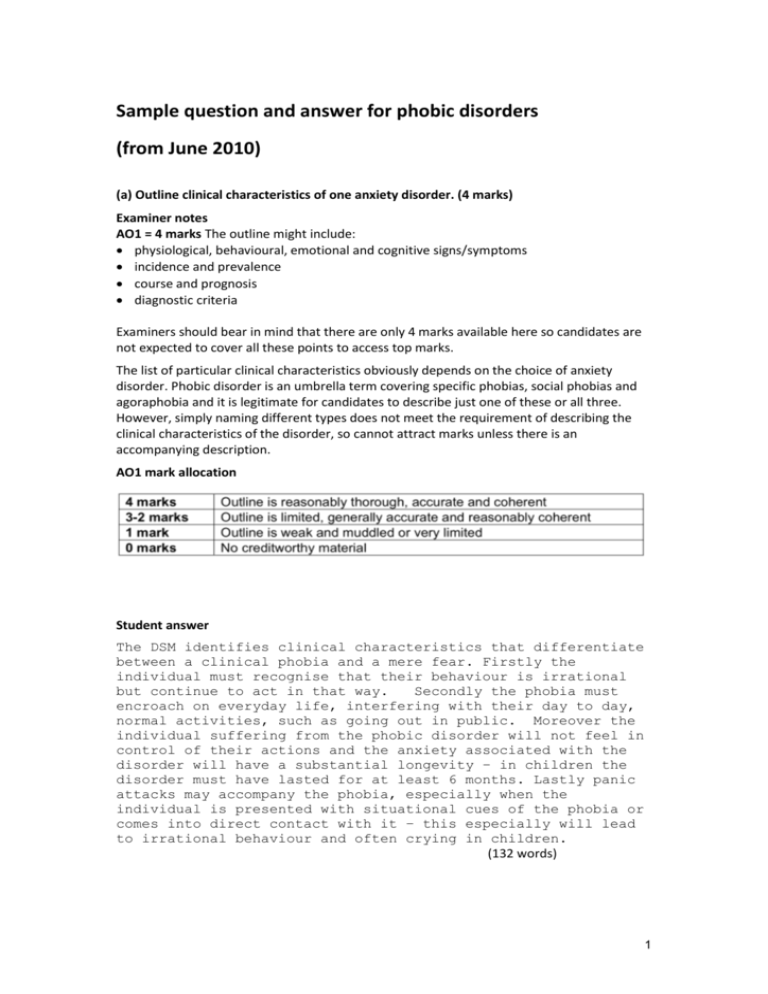
Sample question and answer for phobic disorders (from June 2010) (a) Outline clinical characteristics of one anxiety disorder. (4 marks) Examiner notes AO1 = 4 marks The outline might include: physiological, behavioural, emotional and cognitive signs/symptoms incidence and prevalence course and prognosis diagnostic criteria Examiners should bear in mind that there are only 4 marks available here so candidates are not expected to cover all these points to access top marks. The list of particular clinical characteristics obviously depends on the choice of anxiety disorder. Phobic disorder is an umbrella term covering specific phobias, social phobias and agoraphobia and it is legitimate for candidates to describe just one of these or all three. However, simply naming different types does not meet the requirement of describing the clinical characteristics of the disorder, so cannot attract marks unless there is an accompanying description. AO1 mark allocation Student answer The DSM identifies clinical characteristics that differentiate between a clinical phobia and a mere fear. Firstly the individual must recognise that their behaviour is irrational but continue to act in that way. Secondly the phobia must encroach on everyday life, interfering with their day to day, normal activities, such as going out in public. Moreover the individual suffering from the phobic disorder will not feel in control of their actions and the anxiety associated with the disorder will have a substantial longevity – in children the disorder must have lasted for at least 6 months. Lastly panic attacks may accompany the phobia, especially when the individual is presented with situational cues of the phobia or comes into direct contact with it – this especially will lead to irrational behaviour and often crying in children. (132 words) 1 (b) Briefly describe one psychological therapy for the anxiety disorder that you outlined in your answer to part (a). (5 marks) Examiner notes AO1 = 5 marks AO1 is a brief outline of one psychological therapy for the chosen anxiety disorder. If candidates outline more than one type of therapy, examiners should look at both accounts and credit the one which attracts most marks. Answers which describe a biological therapy eg drugs attract no credit. The most likely therapy is some form of behavioural therapy eg systematic desensitisation or implosion for phobias, or for OCD, ERP or modelling. AO1 mark allocation Student answer Systematic desensitisation is a psychological therapy used to help the suffering individual overcome their fear. Joseph Wolpe originally came up with the therapy and suggested that deep relaxation is the key to overcoming the fear as relaxation and anxiety are not able to occur at the same time. Wolpe came up with the idea of counterconditioning – once an individual is able to relax fully, it is possible to replace the conditioned stimuli to which they have attached their phobia with a more positive conditioned stimuli taking their place. For example, research was carried out where cats were conditioned to acquire a phobia of a box in which they were placed. The researchers gave the cats electric shocks so they were conditioned to have a phobic response to the box. Counterconditioning took place when the cats were fed in the box because they no longer associated it with the box. In order to relate this to humans, Wolpe invented the idea of a desensitisation hierarchy, which has many stages and each brings the phobic closer to confronting their fear. They may find it is not so scary after all but prior to systematic desensitisation they were unable to confront it to find out. Wolpe developed ‘in vivo’ type of systematic desensitisation and also a ‘covert’ type. The former actually requires the phobic to physically confront their fear while the covert type just asks participants to imagine pictures of it. ‘Flooding’ is also associated with systematic desensitisation – individuals are shown their phobia prior to any therapy. (254 words) 2 (c) Evaluate psychological therapies for this anxiety disorder. (16 marks) Examiner notes AO2/3 = 16 marks Candidates are required to evaluate psychological therapies appropriate for the anxiety disorder outlined in (b). Because evaluation can be very generic, partial performance criteria do not apply. They are likely to consider issues such as appropriateness and effectiveness of the therapies. They can also consider the quality of the research evidence which supports the therapies. AO2/3 mark allocation 3 Student answer Subsequent research on systematic desensitisation has confirmed that it is an effective therapy in helping individuals overcome their fears. A significant number of participants responded well to the treatment but it was found that ‘in vivo’ was more effective than the ‘covert’ method. Also systematic desensitisation may, according to research, be more effective on specific phobias rather than social phobias. This may be due to the fact that many specific phobias are exaggerations of ‘ancient fears’ such as snakes and spiders. These phobias are less likely to encroach on the lives of individuals suffering as they are more easily avoidable, whereas social phobias often effect every aspect of a sufferer’s life. A further criticism of systematic desensitisation is that it does not treat the cause of an individual’s phobia but only desensitises them to the symptoms they experience when confronted. If, as Freud suggests, their phobia is a result of early trauma and ego conflict, the individual may subsequently relay their true fear onto another object or situation and the cycle will start again. However, a strength of the theory is that it can be selfadministered and requires little input from participants, so they can go at their own pace. The research mentioned earlier concerning the cats (they were placed in a box and electrocuted to condition a fear response) may have influenced Joseph Wolpe to come up with systematic desensitisation, but it has been criticised for being overly reductionist as it is reducing the complexities of overcoming a phobia to a more simple organism, which raises issues as it is not generalisable to the population. Albert Ellis came up with a different psychological therapy for phobias. He proposed that Rational Emotive Behaviour Therapy (REBT) could cure an individual of an addiction by altering the way in which they think. Phobics have been found to have delusional thoughts about themselves and things around themselves and things around them , which may lead them developing a phobia. Ellis targets these irrational thoughts in his therapy, proposing the ABC model as a way of aiding participants to alter their thinking. This has been found to be effective , especially among social phobics as these are thought to be derived from irrational thoughts in many cases. For example, an individual may see a friend in the street who ignores them (Activating event). They will then display irrational Belief which will lead to a social phobia of going out in the street as a Consequence. (The irrational belief includes irrational thoughts that the person must hate them). This therapy is effective as it targets the causes of an individual’s phobia but it has been criticised as individual differences play a part in its administration. Many people do not respond to REBT as they do not like to be told what to do and cannot be helped under strict conditions. Others flourish under these conditions and their phobias are ‘cured’. 4 REBT also takes a long time to carry out and has been criticised for being too logical – it is not always as straightforward as that as the phobia has been acquired as a result of one particular, irrational thought. Therefore, REBT is also deterministic as there must be other factors involved or the success rate would be 100%. Also REBT cannot help phobics who do not suffer from irrational thinking. (560 words) 5
